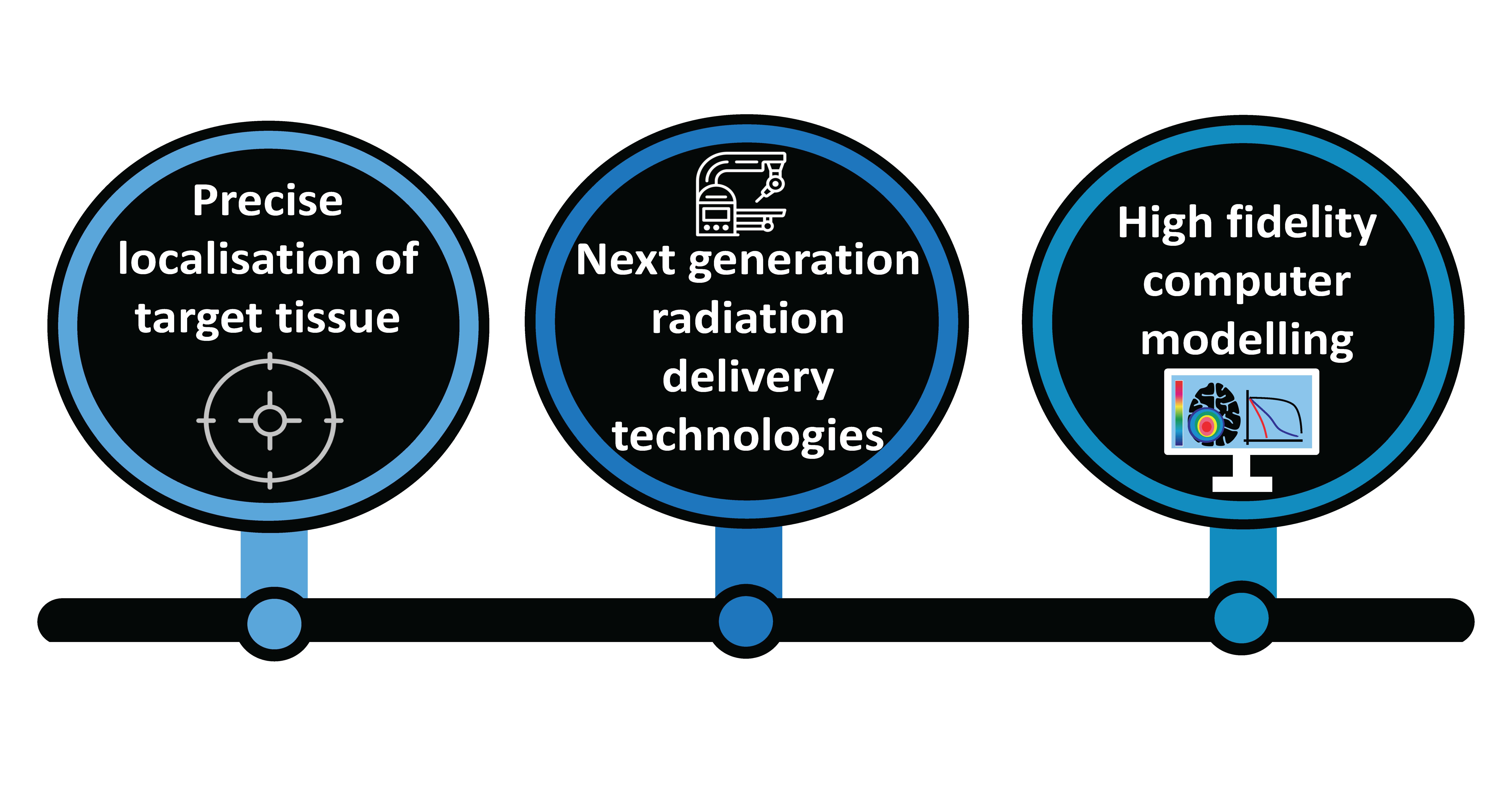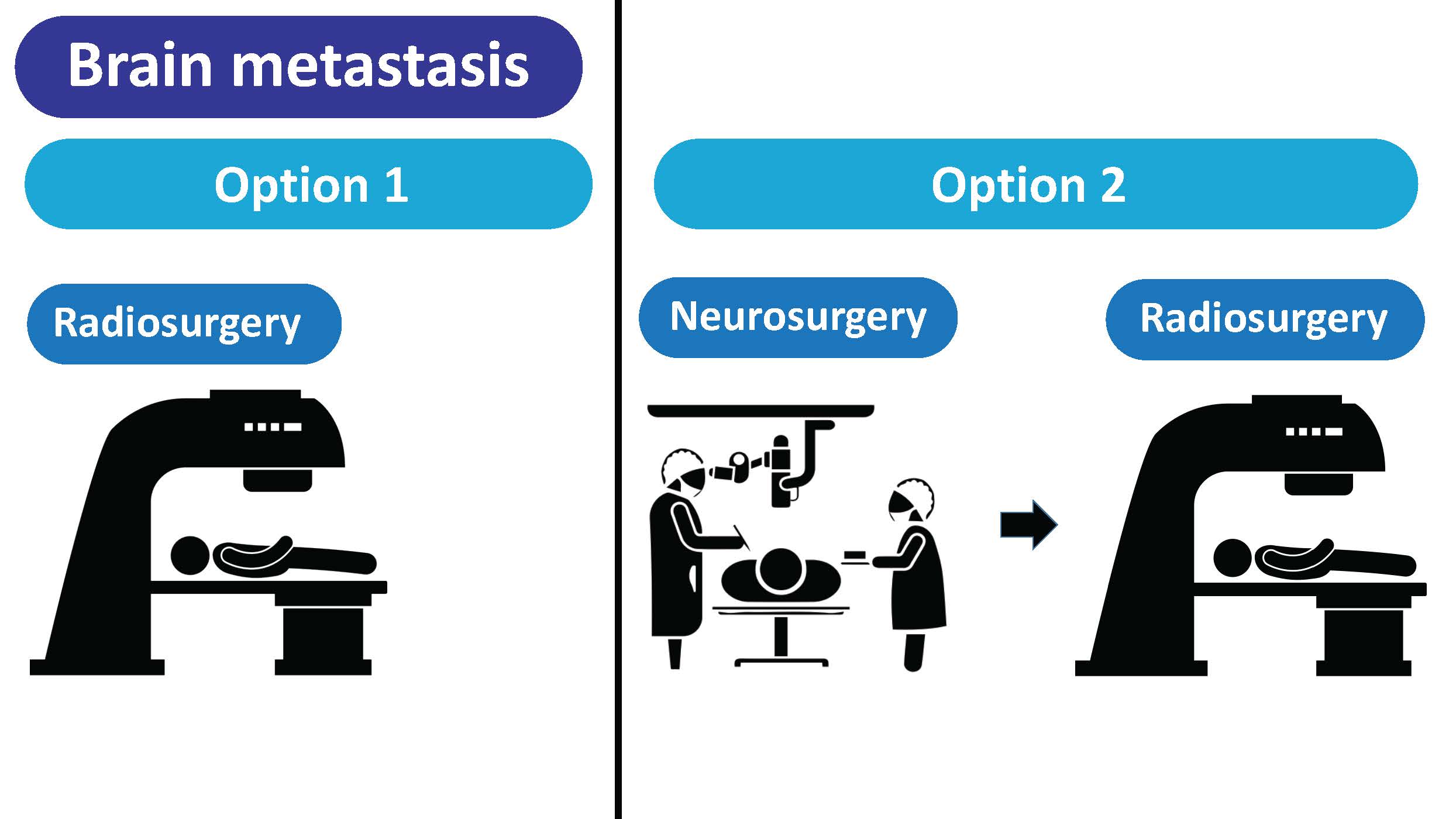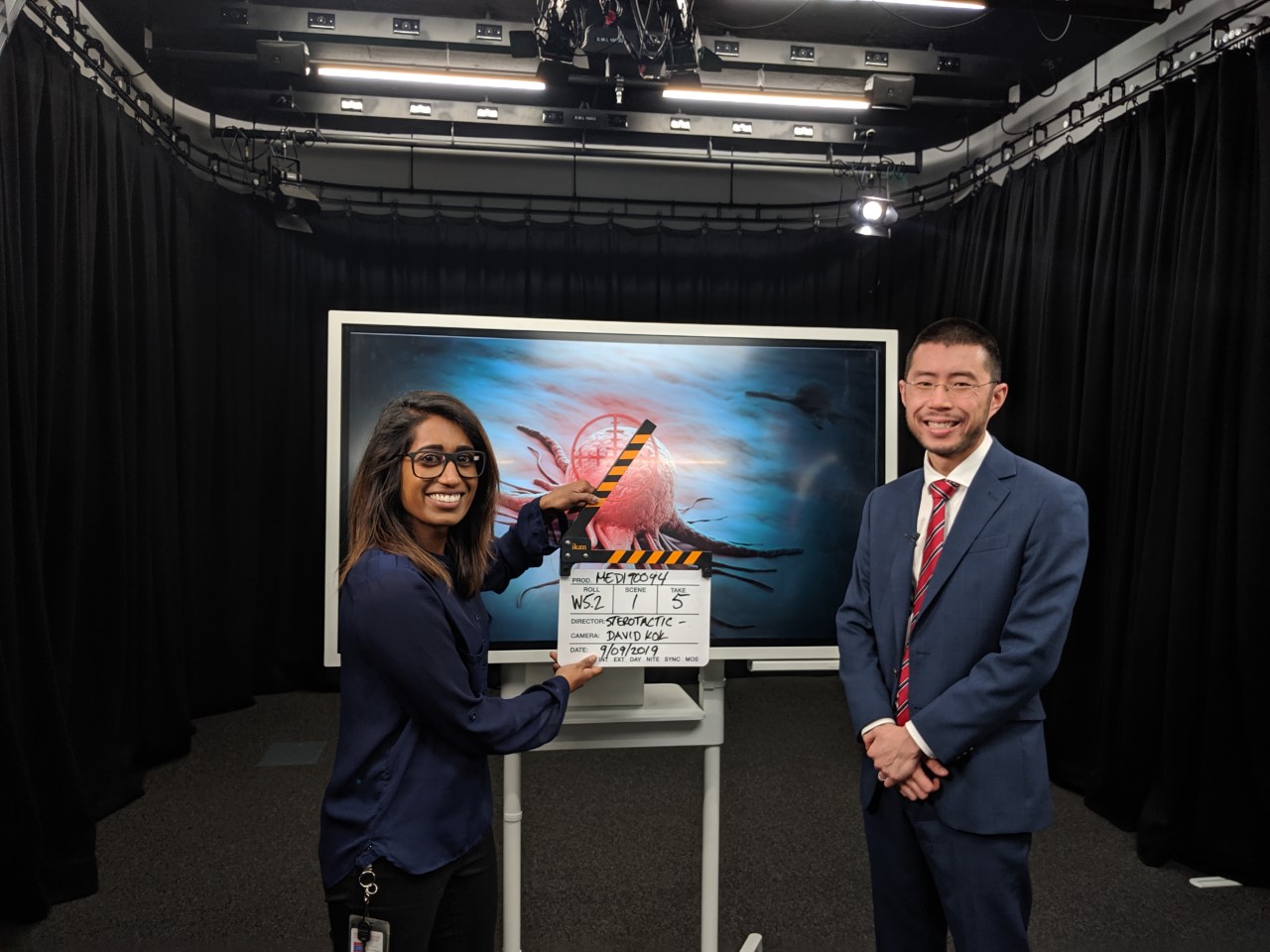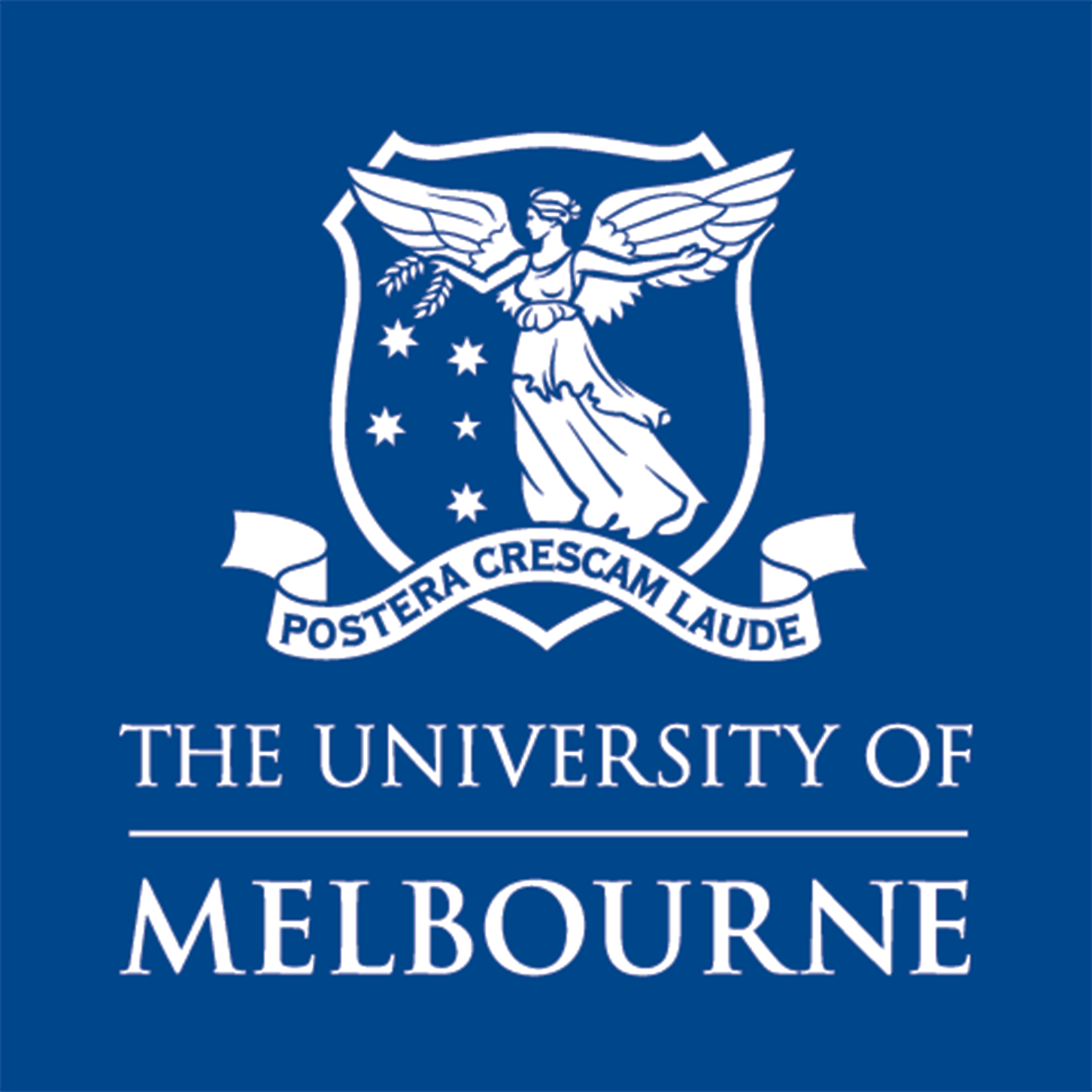Stereotactic Radiotherapy
Stereotactic radiotherapy is a relatively new highly advanced form of radiotherapy, and it's changing how we approach local cancer treatment.
This microlearning explores an educational instructional video presented by Associate Professor David Kok, Radiation Oncologist at Peter MacCallum Cancer Centre and founding Course Convener of the University of Melbourne and VCCC Alliance’s Master of Cancer Sciences.
Aim: To provide an introduction to the technique and principles of stereotactic radiotherapy.
Learning Objectives: During this microlearning you will explore:
-
The definition of key terms of stereotactic radiotherapy
-
The principles of stereotactic radiotherapy
-
The clinical implications of stereotactic radiotherapy
-
The future perspectives of stereotactic radiotherapy
Audience Level: Novice, Intermediate
Stereotactic Radiotherapy
Introduction
Stereotactic radiotherapy involves the delivery of very high doses of radiation to a cancer in a single or short number of sessions with the intent of completely ablating the tumour.
Watch Associate Professor David Kok provide an introduction to stereotactic radiotherapy and define the four most common terms.
Four most common terms
Use the image slider below to explore the definitions of the common terms in stereotactic radiosurgery.
Principles of stereotactic radiotherapy
Watch Associate Professor David Kok discuss the principles of stereotactic radiotherapy.
Technical components
There are three technical components that are necessary to enable safe and accurate delivery of stereotactic radiotherapy.
Three technical components of stereotactic radiotherapy

Case Study: Brain Metastases (secondary brain tumours)
Watch Associate Professor David Kok discuss examples of patients with brain metastases (secondary brain tumours) treated by stereotactic radiotherapy.
Side effects
Watch Associate Professor David Kok discuss the side effects of Stereotactic Radiotherapy.
Clinical implications
Watch Associate Professor David Kok explore current research to discuss the clinical implications of stereotactic radiotherapy.
Neurosurgery vs Radiosurgery
The preferred local treatment for patients with limited brain metastasis is either radiosurgery alone or neurosurgery followed by radiosurgery.

Future perspectives
Watch Associate Professor David Kok discuss future perspectives for stereotactic radiotherapy.
Summary
In summary, stereotactic radiotherapy is a highly advanced method of delivering high dose radiation to a specific target whilst delivering minimal dose to surrounding tissues.
Watch Associate Professor David Kok sum up this new highly advanced form of radiotherapy
References
- Tawbi HA, Forsyth PA, Algazi A, Hamid O, Hodi FS, Moschos SJ, et al. Combined Nivolumab and Ipilimumab in Melanoma Metastatic to the Brain. New England Journal of Medicine. 2018;379(8):722-30. [Slide 40]
- Kocher M, Soffietti R, Abacioglu U, Villa S, Fauchon F, Baumert BG, et al. Adjuvant whole-brain radiotherapy versus observation after radiosurgery or surgical resection of one to three cerebral metastases: results of the EORTC 22952-26001 study. Journal of clinical oncology : official journal of the American Society of Clinical Oncology. 2011;29(2):134-41. [Slide 42]
- Mahajan A, Ahmed S, McAleer MF, Weinberg JS, Li J, Brown P, et al. Post-operative stereotactic radiosurgery versus observation for completely resected brain metastases: a single-centre, randomised, controlled, phase 3 trial. The Lancet Oncology. 2017;18(8):1040-8. [Slide 44]
- Kann BH, Park HS, Johnson SB, Chiang VL, Yu JB. Radiosurgery for Brain Metastases: Changing Practice Patterns and Disparities in the United States. Journal of the National Comprehensive Cancer Network : JNCCN. 2017;15(12):1494-502. [Slide 47]
- Qian JM, Yu JB, Kluger HM, Chiang VL. Timing and type of immune checkpoint therapy affect the early radiographic response of melanoma brain metastases to stereotactic radiosurgery. Cancer. 2016;122(19):3051-8. [Slide 16] 2014;7(4):572-6. [Slide 39]
- Imaging technology news [internet]. Scranton Gillette Communications. [Updated 2019; cited Oct 8 2019] Available from:
https://www.itnonline.com/article/introduction-current-radiation-therapy-treatment-planning-systems [Slide 16]
Brainlab [internet]. Brainlab. [Updated 2019; cited Oct 8 2019]. Available from: https://www.brainlab.com/radiosurgeryproducts/
exactrac/ - Gomez D, Komaki R. Technical Advances of Radiation Therapy for Thymic Malignancies. Journal of Thoracic Oncology. 2010;5(10, Supplement 4):S336-S43. [Slide 24] Phoenix cyberknife [internet]. Phoenix cyberknife. [Updated 2019; cited Oct 8 2019] updated:
https://www.phoenixcyberknifecenter.com/cyberknife-vs-gamma-knife/ - Suh JH. Stereotactic Radiosurgery for the Management of Brain Metastases. New England Journal of Medicine. 2010;362(12):1119-27. [Slide 51]
Video background, awards and acknowledgements
This educational instructional video was produced for the University of Melbourne/VCCC Alliance Master of Cancer Sciences program to explain what makes highly precise stereotactic radiotherapy different from conventional radiotherapy. It is a part of the Cancer Therapeutics subject of the Master of Cancer Sciences. The Master of Cancer Sciences has been recognised as a leader in innovative educational delivery through the International eLearning Awards. It is written and delivered by Associate Professor David Kok, with Dr Sathana Dushyanthen from the University of Melbourne.
Film credits: The University of Melbourne, Victorian Comprehensive Cancer Centre (VCCC) Alliance, Associate Professor David Kok, and Dr Sathana Dushyanthen.

Image: Associate Professor David Kok and Dr Sathana Dushyanthen
Dr Sathana Dushyanthen
Dr Sat Dushyanthen is a cancer researcher and educator at the Victorian Comprehensive Cancer Centre. Sathana completed her PhD at the Peter MacCallum Cancer Centre in a translational science lab, through the University of Melbourne in 2018.
Her research focused on identifying mechanisms to enhance anti-tumour immunity in triple negative breast cancers through the use of small molecule targeted inhibitors and immunotherapy combinations. Additionally, she utilised genetic manipulation and molecular biology techniques, and bioinformatic approaches to study the mechanisms of tumour intrinsic MEK (RAS/MAPK pathway) knockdown. Throughout her PhD Sat was involved in on-campus teaching in the Pathology Department. She is a passionate educator and has previously been involved in developing iBooks for medical faculty. She is also a science communicator and has her own YouTube channel 'Science in Motion (Links to an external site.)'.
Her main interest is in harnessing new technologies and tools to transform teaching and learning in the current age of digital native learners. She also has an interest in educational research. She has lead the development of the Master of Cancer Sciences over the last 4 years.
Associate Professor David Kok
Associate Professor David Kok is a Radiation Oncologist and Medical Educator dually employed by the Peter MacCallum Cancer Centre and The University of Melbourne.
He primarily specialises in the treatment of skin and neurological malignancies, but also treats all tumour types. He has expertise in the use of Stereotactic Radiosurgery, VMAT and Intensity Modulated radiotherapy to achieve the best possible outcomes for his patients. David is heavily involved in postgraduate medical education.
He is the Course Coordinator of the Master of Cancer Science program and also serves as the Director of Training for radiation oncology trainees at the Peter MacCallum Cancer Centre. David is the chief investigator on numerous clinical and translational research trials, including a major research collaborative investigating melanoma brain metastases. He has previously published a thesis on breast cancer treatment patterns and multiple articles relating to best practice in tertiary medical education.
Gold Telly Award
This educational video was awarded the gold medal in the international Telly Awards 2022 presented by Disney, in the Education and Training category.
Resource details

This course is brought to you by


